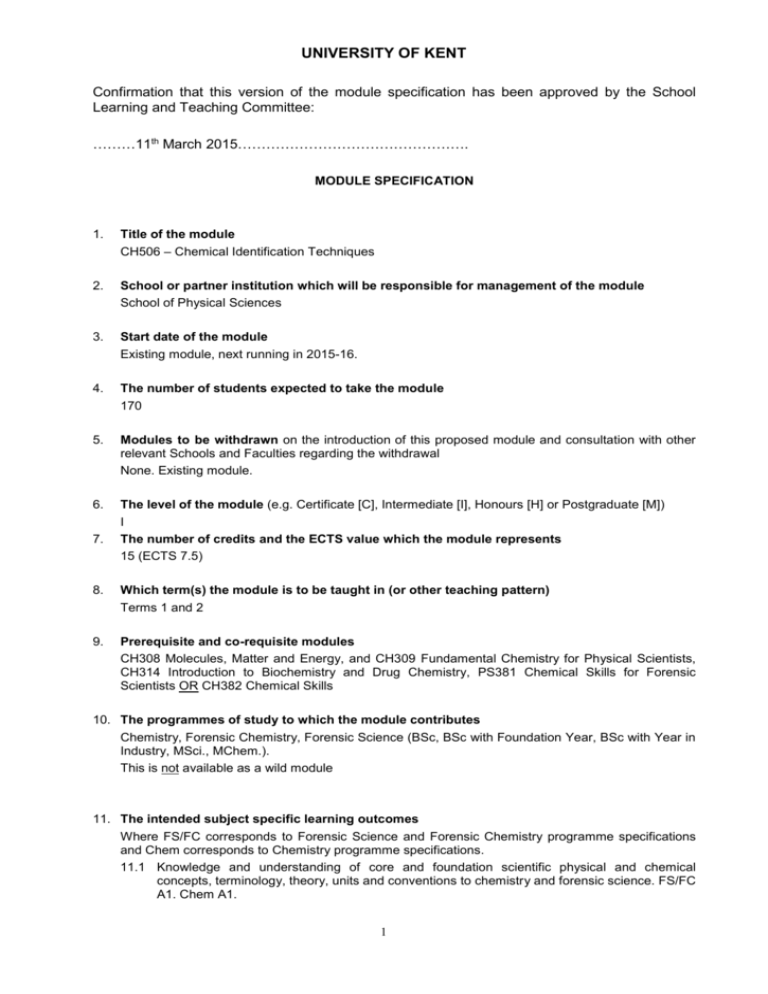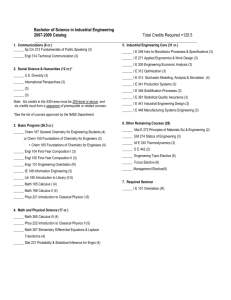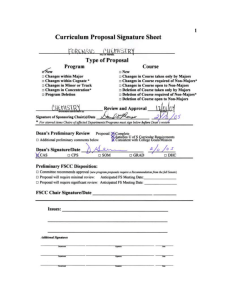module specification
advertisement

UNIVERSITY OF KENT Confirmation that this version of the module specification has been approved by the School Learning and Teaching Committee: ………11th March 2015…………………………………………. MODULE SPECIFICATION 1. Title of the module CH506 – Chemical Identification Techniques 2. School or partner institution which will be responsible for management of the module School of Physical Sciences 3. Start date of the module Existing module, next running in 2015-16. 4. The number of students expected to take the module 170 5. Modules to be withdrawn on the introduction of this proposed module and consultation with other relevant Schools and Faculties regarding the withdrawal None. Existing module. 6. The level of the module (e.g. Certificate [C], Intermediate [I], Honours [H] or Postgraduate [M]) I The number of credits and the ECTS value which the module represents 15 (ECTS 7.5) 7. 8. Which term(s) the module is to be taught in (or other teaching pattern) Terms 1 and 2 9. Prerequisite and co-requisite modules CH308 Molecules, Matter and Energy, and CH309 Fundamental Chemistry for Physical Scientists, CH314 Introduction to Biochemistry and Drug Chemistry, PS381 Chemical Skills for Forensic Scientists OR CH382 Chemical Skills 10. The programmes of study to which the module contributes Chemistry, Forensic Chemistry, Forensic Science (BSc, BSc with Foundation Year, BSc with Year in Industry, MSci., MChem.). This is not available as a wild module 11. The intended subject specific learning outcomes Where FS/FC corresponds to Forensic Science and Forensic Chemistry programme specifications and Chem corresponds to Chemistry programme specifications. 11.1 Knowledge and understanding of core and foundation scientific physical and chemical concepts, terminology, theory, units and conventions to chemistry and forensic science. FS/FC A1. Chem A1. 1 UNIVERSITY OF KENT 11.2 Knowledge and understanding of areas of analytical, physical, organic and inorganic chemistry as applied to chemistry and forensic science. FS/FC A3. Chem A3. 11.3 An ability to demonstrate knowledge and understanding of essential facts, concepts, principles and theories relating to chemical identification techniques and to apply such knowledge and understanding to the solution of qualitative and quantitative problems. FS/FC B1. Chem B5. 11.4 An ability to recognise and analyse novel problems related to chemical identification and plan strategies for their solution by the evaluation, interpretation and synthesis of scientific information and data. FS/FC B2. Chem B6. 11.5 Ability to recognise and implement good measurement science and practice and commonly used chemistry and forensic laboratory techniques. FS/FC B4. Chem B4. 11.6 Ability to interpret data derived from laboratory observations and measurements in terms of their underlying significance and the theory underpinning them. FS/FC C6. Chem C11. 12. The intended generic learning outcomes Where FS/FC corresponds to Forensic Science and Forensic Chemistry programme specifications and Chem corresponds to Chemistry programme specifications. 12.1 Interpersonal skills, relating to the ability to interact with other people and to engage in team working within a professional environment. FS/FC C6. Chem C19. 12.2 Time-management and organisational skills, as evidenced by the ability to plan and implement efficient and effective modes of working. Self-management and organisational skills with the capacity to support life-long learning. FS/FC C6. Chem C20. 12.3 Problem-solving skills, relating to qualitative and quantitative information, extending to situations where evaluations have to be made on the basis of limited information. FS/FC D2. Chem D15. 12.4 Information-retrieval skills, in relation to primary and secondary information sources, including information retrieval through on-line computer searches. FS/FC D4. Chem D17. 12.5 Study skills needed for continuing professional development and professional employment. FS/FC D9. Chem D21. 13. A synopsis of the curriculum Nuclear Magnetic Resonance: Simple theory of nuclear magnetic resonance, NMR. The NMR experiment and the spectrometer. The chemical shift and factors which affect it. Spin-spin coupling. Nomenclature of spin systems. Coupling constants. Simple 2nd order effects. Labile protons and NMR (alcohols, acids and amines). Magnetic and chemical inequivalence. Introduction to 13C NMR spectroscopy. Mass Spectrometry: Basic theory and operation of the magnetic sector mass spectrometer. Interpretation of mass spectral data and fragmentation mechanisms. Gas chromatography/mass spectrometry. Infrared and Raman Spectroscopy: Experimental details. Applications of characteristic group frequencies. Determination of symmetry of simple molecules. Basic Diffraction Methods: Diffraction. Generation of x-rays. Synchrotron sources. Neutron sources. Basic crystallography. Bravais lattices. Unit cells. Symmetry. Space groups. Bragg’s Law. Powder patterns. Systematic absences. Indexing powder patterns. Single crystal x-ray diffraction. Structure identification.Some of the uses of diffraction. Diffraction in Forensic Science UV-vis and Fluorescence Spectroscopy: Description of the theory of UV-vis electronic absorption. Colours of compounds and materials. HOMO-LUMO transitions and conjugation in -systems. Typical organic chromophores and their absorption frequencies. Molar absorptivities and the BeerLambert Law. UV-vis spectra of inorganic compounds. Instrumentation and equipment for UV-vis spectrophotometry. Uv-vis and RI detectors in HPLC. Basic theory of fluorescence spectroscopy. Excitation and relaxation. Stokes shift. Excitation and emission spectra. 14. Indicative Reading List Chang, Physical chemistry for the chemical and biological sciences. [QD 453.2] Williams and Fleming, Spectroscopic methods in organic chemistry. [QDA76] 2 UNIVERSITY OF KENT Abraham, Fisher and Loftus, Proton and carbon-13 NMR spectroscopy. [QD591] W. Kemp, Organic Spectroscopy (3rd Ed), Macmillan 1991. [QD 272.S6] Anthony R. West, Solid State Chemistry and Its Applications [QD454] Fundamentals of molecular spectroscopy - Banwell, Colin N., McCash, Elaine M. 1994 15. Learning and Teaching Methods, including the nature and number of contact hours and the total study hours which will be expected of students, and how these relate to achievement of the intended module learning outcomes 29 hours of lectures 10 hours of workshops 4 hours of example classes 2 hours of revision sessions Total study hours 150 Achievement of module learning outcomes: Lectures (11.1, 11.2, 11.3, 11.4, 11.5, 11.6, 12.1) Laboratories (11.1, 11.5, 11.6, 12.1, 12.2, 12.3, 12.4, 12.5) Example classes (11.1, 11.2, 11.3, 11.4, 12.1, 12.5) Revision session (11.1, 11.2, 11.3, 11.4, 12.1, 12.2, 12.5) Independent study (11.1, 11.2, 11.3, 11.4, 12.1, 12.2, 12.3, 12.4, 12.5) 16. Assessment methods and how these relate to testing achievement of the intended module learning outcomes Coursework: 35%. 4 Assignments Learning outcomes related to individual assignments: 11.1, 11.2, 11.3, 11.4, 11.6, 12.2, 12.3, 12.4, 12.5. 2 workshop assignments Learning outcomes related to workshops: 11.1, 11.2, 11.3, 11.4, 11.5, 11.6, 12.1, 12.2, 12.3, 12.4, 12.5. Examination (length 2 hours): 65% Learning outcomes related to examination: 11.1, 11.2, 11.3, 11.4, 12.2, 12.3, 12.5. 17. Implications for learning resources, including staff, library, IT and space None. Existing module. 18. The School recognises and has embedded the expectations of current disability equality legislation, and supports students with a declared disability or special educational need in its teaching. Within this module we will make reasonable adjustments wherever necessary, including additional or substitute materials, teaching modes or assessment methods for students who have declared and discussed their learning support needs. Arrangements for students with declared disabilities will be made on an individual basis, in consultation with the University’s disability/dyslexia support service, and specialist support will be provided where needed. 19. Campus where module will be delivered: Canterbury 3 UNIVERSITY OF KENT 4





